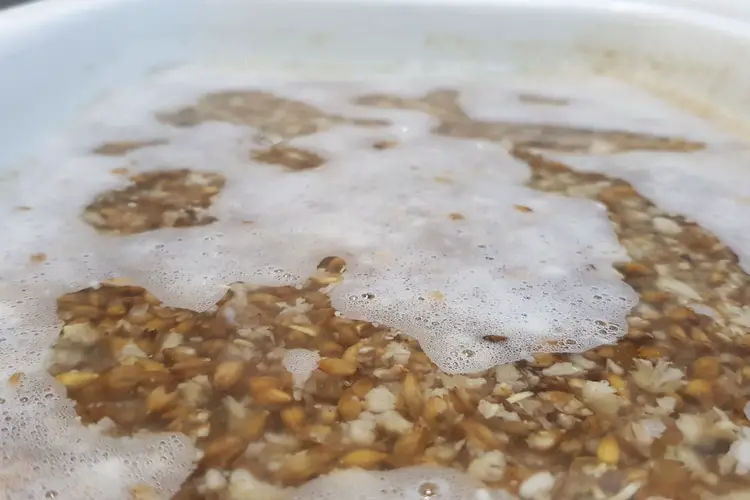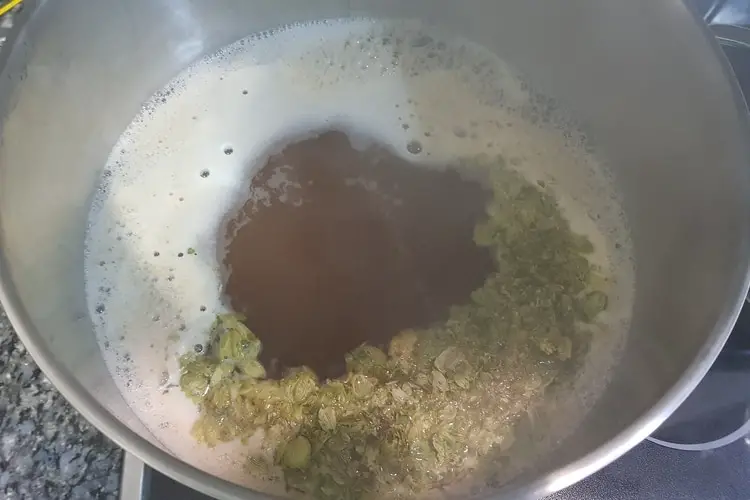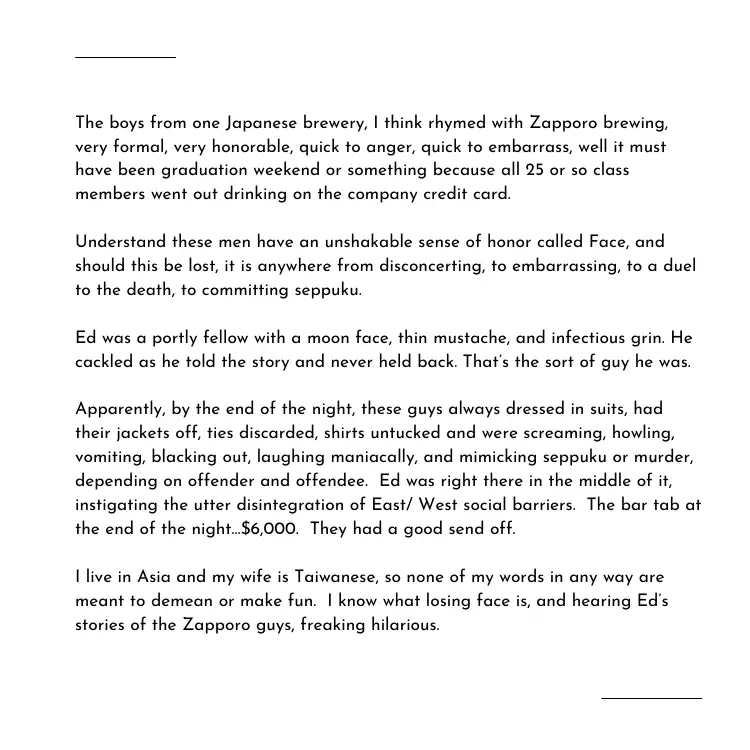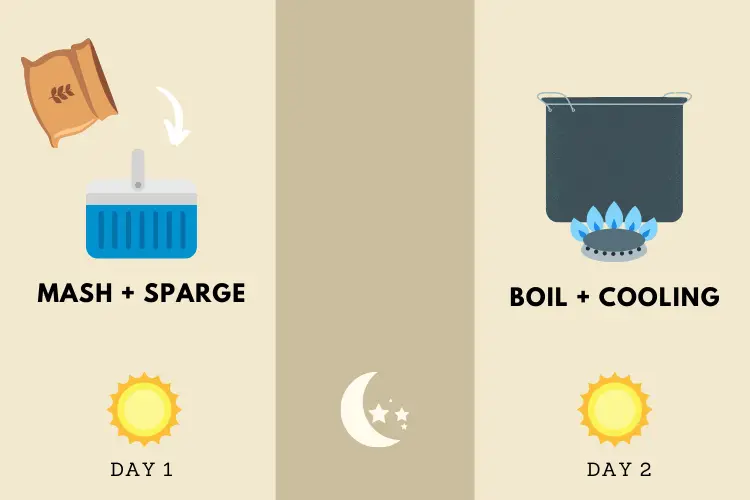Due to a hectic life, small space, or any host of reasons, folks will ask, “Can I stretch my brew over 2 days?” I would say no, there are too many factors involved. For ordinary beer, the process was not intended to last overnight. On the other hand, it’s just homebrew, we should enjoy it, no? Then, I could offend the most dedicated brewers who may insist I take it more seriously. Either way, we’ll go over the options.
You can brew overnight and split Brew Day over 2 days but it’s not recommended. Wort can sour and microbes sneak in. Infection or off-flavors (DMS) will show regardless of boil. There are too many variables at play.
Some beers were meant to be brewed overnight. We’ll take a closer look at those.
A person is busy. Current events aside, there is work, family, and obligations. OK, so I’ll shoot it as straight as I can.
Day 1: Mashing + Sparging

We’ll start out from the premise that all-grain brewing is the goal, but there is simply not time all in one day.
Assume also that 5 gallons is the goal as this was the standard brew-size and new equipment kits are Dorian’s department.
To Do:
- Prep equipment: 15m.
- Weigh and crack the grist (even with a drill or motor): 30m.
- Heat mash water (depends on ambient temperature; mine was cool well water, 48˚F): 20m.
- Mash: 90m. Yes, I insist.
- Vorlauf: 20 m. (Heating sparge water here)
- Sparge: 70m. +/-
The total time investment is just over 4 hours.
This could be shaved down, but let’s round up for good measure.
Do not rush the mash.
This is the critical step for complete sugar conversion.
Nor should one rush the sparge, as it is the critical step for complete extraction of all fermentable sugars.
Problems that may arise
The wort has to be cooled, even if uncooked. It will be around 165˚ F (73° C) and it is difficult to cool.
Then there must be a cold place to store it.
I do not recommend cooling it overnight.
For details on this process please thoroughly read, 3 Consequences of Leaving Wort to Cool Overnight.
DMS (dimethyl sulfide) will form in hot wort.
It usually gets cooked out in the boil but reforms in hot wort that sits. It is a thermally released amino acid (with sulfur) present in all malt.
Long story short, cool wort slowly and it will release DMS giving the flavor of cooked vegetables and the favorite soup in all of the Taiwan Island State, Corn Chowder.
Not recommended.
Instances where overnight Mashing or Sparging is OK
If brewing a traditional Hefe-Weizen style, the mash may be left for an Overnite Sensation (FZ, anyone?) of authentic flavor.
The mash will sour, and lactic acid will form from the wild airborne bacterium and that living on the malt itself.
True the sparge and boil will kill off the wild microorganisms, but a host of flavors will remain, all due to an unknown level of contamination:
- Phenolic – Bitter, spicy, herbal, tea-leafy, clove-like, medicinal.
- Cheesy (Isovaleric Acid): Gouda cheese, rancidity, goaty, dirty socks, horse blanket, barnyard
- Caprylic (octanoic or caprylic acid): Goatish, tallow-like, vegetable oil, waxy, goat cheese
In some instances, these are desirable flavors.
In 99.6% they are not. Do not play these odds.
Sour beers
I’m a huge fan. Lambic beer is my favorite style, not even close.
Flemish Reds also, and there are some wild yeasts being cultivated in America now and their terroir defined; a domain previously occupied only by the Belgians.
There is an excellent article I recommend called, “Notes of “horse blanket” and “burnt Band-Aid”: How wild yeasts are bringing offbeat terroir to craft beer.”
These are tricky beers to emulate though you can read about some interesting experiences I had in the glory days back at the Ol’ FBBC (French Broad Brewing Co.). Check my article on How to make a Lambic at home.
Also…….. ok, I’m back. My eyes just rolled back to center; my irises are visible now.
If you want to try to make a gose style, it needs to be soured overnite (not a sensation), not dosed with lactic acid, nor artificially inseminated with lactobacillus and killed in the kettle during mash out or boil.
My local 7-11 convenience store has a beer promoted by the Taipei- based Taihu Brewing Company, who by the way have the contract to sell beer in Starbucks, Southern China Division – Tomato Plum Gose!!! Is it a wonder I have eye problems?
Day 2: Boil + Cooling

After the first day, whatever happened to the wort on day one must be dealt with.
I gave two examples of risks taken.
DMS will form.
A host of other compounds will form due to even a modest infection, should there be such a thing.
The wort is an enzymatic soup full of complex proteins, amino acids and chemical compounds bursting to react chemically given the chance.
There are multiple forum threads wherein it is written, on whatever it is they write in on up there, if anything ever bad ever happens to your wort, as a result of some sort of conflict with anyone named Nanook… (FZ, anyone?) Sorry got lost again, thinking of gose.
It is said repeatedly within the forums, there is little problem letting wort sit overnight – opposite of sensation.
I think of yet another classic song called, I’m the Slime.
True, homebrewers will encounter less problems than commercial due to scale.
I will not reveal the secrets to their success as I am incredulous.
It is crazy talk, pure crazy talk.
Instances where overnight Mashing or Sparging is OK
I can think of two.
One is overnight wort cooling in order to infect your wort.
As in the article references above, it is being done.
Nine times out of ten you will get an undrinkable putrification.
You may get lucky.
Brewing is not a process of luck.
Also, and this is the fun part, without revealing too many secrets, were you to be brewing a Flemish Red or Old Brown Style, OK, I lied, this is my favorite and I could drink them endlessly, an overnite sensational kettle boil, or day long boil is the key to the highway, the essence of On the Road.
Old Brown’s color comes not from specialty malts in the mash, but from black candi sugar, a bit of steeping and kettle browning. An old brown has an amazingly low to miniscule amount of dark malts in the mash, maybe 0.6 – 1%. So, why so lush, deep deep Ruby red to a glowing opaque brown?
Kettle steeping with black malt is one choice.
Another is a 4 – 8 hour boil, yeah, you heard right.
A long boil undergoes the Maillard reaction.
This is a natural browning due to prolonged heating. It creates melanoidins, a mix of sugar and amino acids that give browned food its distinctive baked flavor, even in beer.
My best recommendation for the busiest among us
It’s really quite easy, stick to extract and flavoring malts. It is a no-nonsense method, tried and true which will make tasty respectable beer, mimicking any style, any flavor, anywhere.
Here’s proof. I knew this wild man brewer named Ed Collins. He was an active brewer in the 80’s and 90’s. He apprenticed at Hoster Brewing in Columbus, Ohio, and attended the Siebel Institute of Brewing Science in Chicago, Illinois: the long course. He had some hilarious stories from Siebel but that is for another time.
OK, one quick one…

I digress.
One of Ed’s first jobs was a little brewpub in Florida in the early 90’s.
Back then, during the first heyday, restaurateurs would mark out a tiny footprint for a brewery, some as little as 100 – 200 square feet.
In this case, Ed had an extract system wherein he brewed a Scotch Ale, a Strong Red ale, heavy in the caramel that weighed in about 6.2%.
Back then, I think…Florida was one of the few Southern states allowing an alcohol percentage over 6%.
Anyway! Long story short, he won the silver medal that year at the GABF, THE Great American Beer Festival with an extract beer!
Scotch ale is stronger, has a strong specialty grain malt – caramel, chocolate, black, roasted, Special B, C, D, and K character, extremely malty, and in the end, the judges didn’t notice. Go figure…

